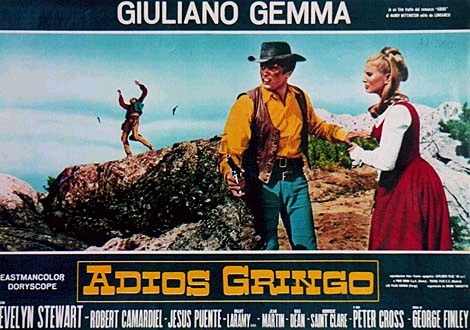The fourth Gemma western of 1965, and the fourth hit. Adios Gringo even beat the two Ringo movies at the box office, ending third on the list of most successful westerns of the year, behind For a Few Dollars More and that other Gemma vehicle, One Silver Dollar. With four movies in the box-office Top 5, 1965 definitely was Gemma’s year.
Adios Gringo is based on an novel by American writer of pulp fiction Henry Whittington (who allegedly wrote 85 novels within 12 years!). It’s therefore no wonder that it’s one of the more Americanized spaghetti westerns. Gemma is a cowboy, Brett Landers, who is falsely accused of stealing cattle when he rides his livestock into town. Things get worse when he shoots the rightful owner in self-defense, but is nearly lynched by the townspeople. He escapes but promises to come back to prove his innocence. His only lead is the name of the man who sold him the cattle in the first place, Gil Clawson, a former acquaintance turned bandit. While following the man’s footsteps, he saves the life of a woman who was raped after a stagecoach robbery and left behind, tied naked to four poles, to die from thirst and sun-glare. It turns out that one of the rapists – and stagecoach robbers – is the son of the mightiest man in the region, who’ll do everything to protect the perverted young man. One of the good-for-nothings teaming up with the pervert, is of course Gil Clawson.
Vlcsnap-2012-02-10-19h34m09s232.png
Vlcsnap-2012-02-10-18h11m53s86.png
The opening, with the false accusation and the accused surviving a lynch mob, seems to have influenced Clint Eastwood’s stateside spaghetti western Hang ‘m High, in which even the theme of the brutally raped and tortured woman returns. Although the actual rape is not shown and Stewart’s naked body is hidden from view by Gemma’s stature when he approaches her, the sequence is quite nasty. Violence towards women is a recurring theme in spaghetti westerns, as some discussions on the forum have pointed out. But while in some other films the suggestion is made that women might like these things, here rape and torture are used to underline how bad the villains are. There’s never any suggestion made that it can be excused, quite on the contrary a few hints are made at the hypocrisy of men, who tend to blame the victim of a rape rather than the rapists.
Adios Gringo was Giorgio Stegani’s first of three westerns as a director. He had co-written the script of One Silver Dollar and had also been assistant-director to Giorgio Ferroni. In the previous year, he had also been assistant-director to Gérard Oury on the immensely successful Bourvil-De Funès comedy Le Corniaud. He was known to be a very gentle person, who gave his actors a lot of freedom. This was probably the reason why he was asked to direct Adios Gringo by Gemma, who was the raison d’être of this movie. In his home country Gemma used his Italian name for the first time and it’s probably as much his film as Stegani’s. This seems to have led to an excess of fistfights (giving Gemma the opportunity to show all physical and athletic abilities) and an extended role for Gemma’s personal friend Pazzafini, who’s a real supporting actor here, with more screen time than main villain Righi.
While Gemma shows little of the cynical attitude of the spaghetti western hero, the violende is more graphic than in his previous movies. There quite a lot of blood for a spaghetti western from 1965, a man is nailed to a wall by piercing his hand and the traditional fistfight between Gemma and Pazzafini is remarkably crude. But overall we’re on the sunny side of things. It’s a cruel world, but in the end justice prevails. Like French author Giré has noted, we’re far removed from the pessimist world of Leone with its shady and ambiguous characters. The script is predictable, even clichéd, and the characters are stereotypes (1). Cressoy (who often played similar roles in early spaghettis) is nevertheless quite convincing as the patriarch, authoritarian, despotic, but not without a consciousness. Righi was well-cast as the piece of vermin: he looks as trustworthy as a ferret who’s about to thrust his teeth in a rabbit’s neck. There’s a good Roberto Carmadiel too, cast against type as a wise doctor instead of the usual comical sidekick. Benedetto Ghiglia’s score is both lively and lovely, but the cheesy theme song (Gringo, Gringo, pom, pom, pom) is nearly hilarious.

